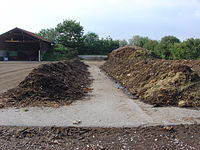
Photo from wikipedia
Soilborne pathogens and pests in agroecosystems are serious problems that limit crop yields. In line with the development of more ecologically sustainable agriculture, the possibility of using biochar to control… Click to show full abstract
Soilborne pathogens and pests in agroecosystems are serious problems that limit crop yields. In line with the development of more ecologically sustainable agriculture, the possibility of using biochar to control pests has been increasingly investigated in recent years. This work provides a general overview of disease and pest suppression using biochar. We present an updated view of the literature from 2015 to 2022 based on 61 articles, including 117 experimental case studies. We evaluated how different biochar production feedstocks, pyrolysis temperatures, application rates, and the pathosystems studied affected disease and pest incidence. Fungal pathogens accounted for 55% of the case studies, followed by bacteria (15%), insects and nematodes (8%), oomycetes and viruses (6%), and only 2% parasitic plants. The most commonly studied belowground pathogen species were Fusarium oxysporum f. sp. radicis lycopersici in fungi, Ralstonia solanacearum in bacteria, and Phytophthora capisci in oomycetes, while the most commonly studied pest species were Meloidogyne incognita in nematodes, Epitrix fuscula in insects, and both Phelipanche aegyptiaca and Orobanche crenata in parasitic plants. Biochar showed suppression efficiencies of 86% for fungi, 100% for oomycetes, 100% for viruses, 96% for bacteria, and 50% for nematodes. Biochar was able to potentially control 20 fungal, 8 bacterial, and 2 viral plant pathogens covered by our review. Most studies used an application rate between 1% and 3%, a pyrolysis temperature between 500 °C and 600 °C, and a feedstock based on sawdust and wood waste. Several mechanisms have been proposed to explain disease suppression by biochar, including induction of systemic resistance, enhancement of rhizosphere competence of the microbial community, and sorption of phytotoxic compounds of plant and/or microbial origin. Overall, it is important to standardize biochar feedstock and the rate of application to improve the beneficial effects on plants in terms of disease control.
Journal Title: Plants
Year Published: 2022
Link to full text (if available)
Share on Social Media: Sign Up to like & get
recommendations!